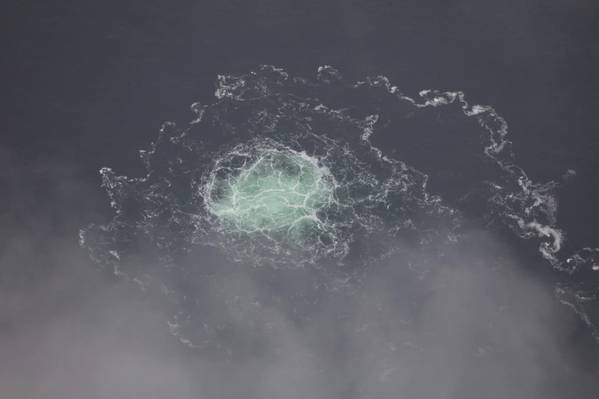
Major leaks that suddenly erupted in the Nord Stream gas pipelines that run from Russia to Europe under the Baltic Sea have generated plenty of theories but few clear answers about who or what caused the damage.
Here is what we know and what has been said so far:
WHO IS BEING BLAMED?
As probes by European authorities continue, the Swedish security police said on Thursday that suspicions of gross sabotage on the pipelines had been strengthened following a crime scene investigation.
The Danes are also carrying out an investigation, with both countries excluding Russia from the probes.
Russia's foreign ministry said on Thursday it was "unthinkable" that an investigation into ruptures on the Nord Stream 1 and 2 gas pipelines would proceed without Moscow's participation.
So far, Western governments and officials have avoided pointing a finger directly, while Russia has blamed the West.
Fatih Birol, the head of the International Energy Agency, said it was "very obvious" who was behind it but did not say who that was.
The Kremlin said allegations of Russian responsibility were "stupid" and Russian officials have said Washington had a motive as it wants to sell more liquefied natural gas (LNG) to Europe.
President Vladimir Putin said on Friday the United States and its allies blew up Nord Stream. "The sanctions were not enough for the Anglo-Saxons: they moved onto sabotage," he said.
In previous comments, the White House has dismissed the accusation that it was responsible. U.S. President Joe Biden said on Friday damage to Nord Stream was a deliberate act of sabotage.
WHY SABOTAGE A PIPELINE?
German Navy Chief Jan Christian Kaack told German daily Die Welt in its Sept. 26 edition, the day leaks were first reported although he was apparently speaking before that: "Russia has also built up considerable capacity underwater. At the bottom of the Baltic Sea, but also in the Atlantic, there is quite a bit of critical infrastructure like pipelines or submarine cables for IT."
Alongside Nord Stream, a new pipeline has been built between gas producing Norway and Poland, which has been seeking to end its reliance on Russian energy, making the region highly sensitive for Europe's energy security.
"(Russia) can intimidate Europeans through an act of sabotage. Because if they're able to blow up these pipelines in the Baltic seabed, they could do that as well to the new pipeline," said Kristine Berzina, senior fellow for security and defense at the German Marshall Fund.
However, if it was an act of sabotage, it has damaged pipelines that were built by Kremlin-controlled Gazprom and its European partners at a cost that ran into billions of dollars.
The damage also means Russia loses an element of leverage it still had over Europe, which has been racing to find other gas supplies for winter, even if the Nord Stream pipelines where not pumping gas when the leaks were discovered, analysts say.
Whoever or whatever is to blame, Ukraine may also be a beneficiary. Kyiv has long called for Europe to halt all purchases of Russian fuel - even though some gas still runs to Europe across its territory. Disrupting Nord Stream brings Kyiv's call for a full Russian fuel embargo closer to reality.
HOW COULD NORD STREAM HAVE BEEN DAMAGED?
Experts say the scale of the damage and the fact that the leaks are far from each other on two different pipelines indicate that the act was intentional and well-orchestrated.
Seismologists in Denmark and Sweden said they had registered two powerful blasts on Monday, Sept. 26, in the vicinity of the leaks, and the explosions were in the water, not under the seabed.
Swedish prosecutor Mats Ljungqvist, who is in charge of the preliminary investigation, confirmed in a statement on Thursday that there were detonations at Nord Stream 1 and 2 in the Swedish economic zone which caused extensive damage to the gas pipelines.
He added that evidence had been seized at the scene but details were confidential as the case was sensitive.
A British defense source told Sky News the attack was probably premeditated and detonated from afar using underwater mines or other explosives.
"Something big caused those explosions which means ... Russia could do it. In theory, the United States could also do it but I don't really see the motivation there," Oliver Alexander, an open source intelligence analyst, told Reuters.
The United States had long called for Europe to end its reliance on Russian gas, he said, but Washington had little obvious motivation to act now because Nord Stream was no longer pumping gas to Europe at the time the leaks were found, although the pipelines had gas under pressure inside them.
"They already succeeded in stopping Nord Stream 2. It was already dead in the water, it wasn't going anywhere," he said.
Analysts say it is possible the damage was inflicted by devices that are available on the commercial market but that given the scale and precision, it was more likely carried out by an actor with access to more sophisticated technology.
The U.S. news channel CNN, citing three sources, reported that European security officials had observed Russian navy support ships and submarines not far from the sites of the Nord Stream leaks. Asked about the report, Kremlin spokesman Dmitry Peskov said there had been a much larger NATO presence in the area.
WHAT HAPPENS NEXT?
The Europeans, including the Danes, are pressing on with their investigations with further results expected soon.
For now, however, more direct fingerpointing between Russia and the West could worsen tensions that have already spiraled over the war in Ukraine, said Marek Swierczynski, a defense analyst for Polish think tank Polityka Insight.
Map: Leaks reported from Russian Nord Stream pipelines https://tmsnrt.rs/3dTx8JE
(Reporting by Reuters bureaus, with additional reporting by Sabine Seibold; Editing by Alexander Smith, Edmund Blair and Emelia Sithole-Matarise)



